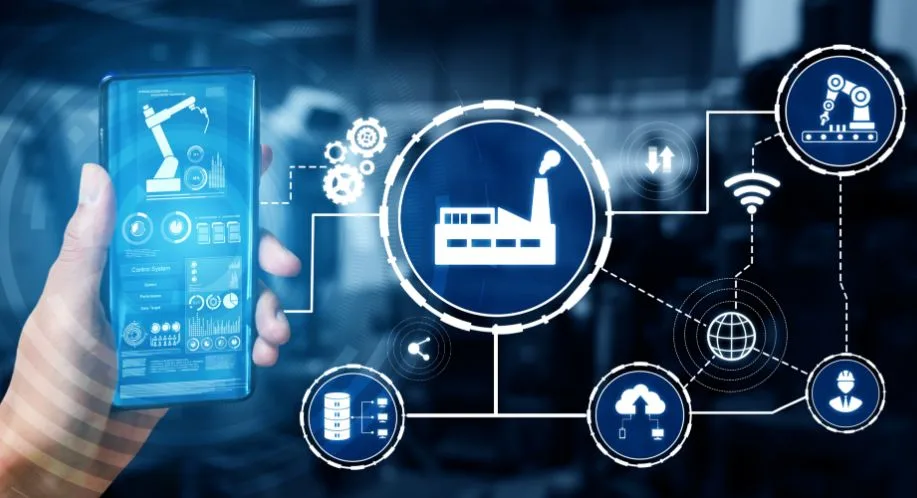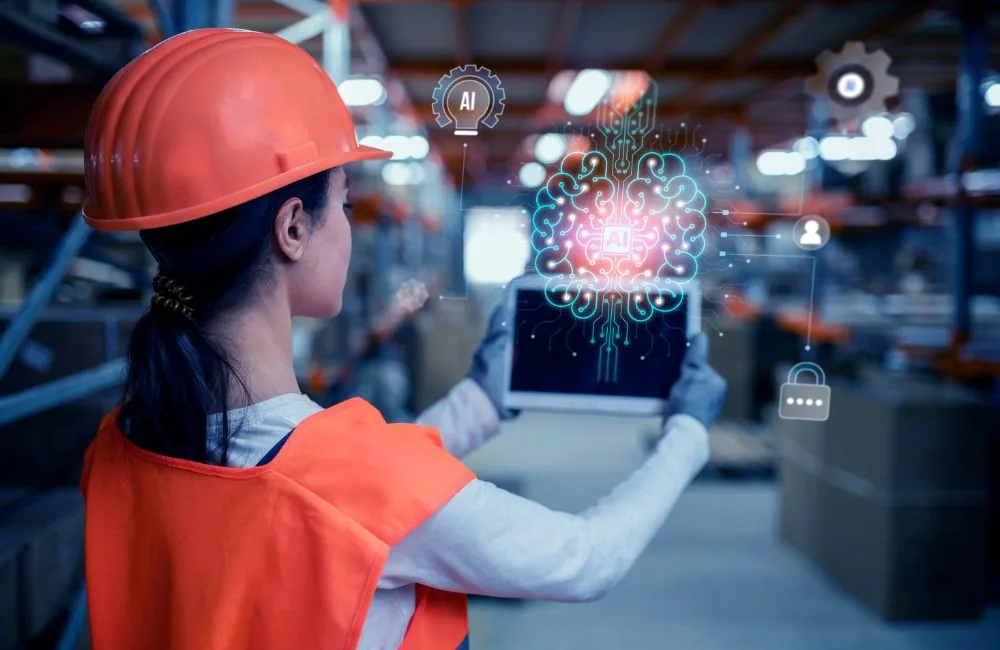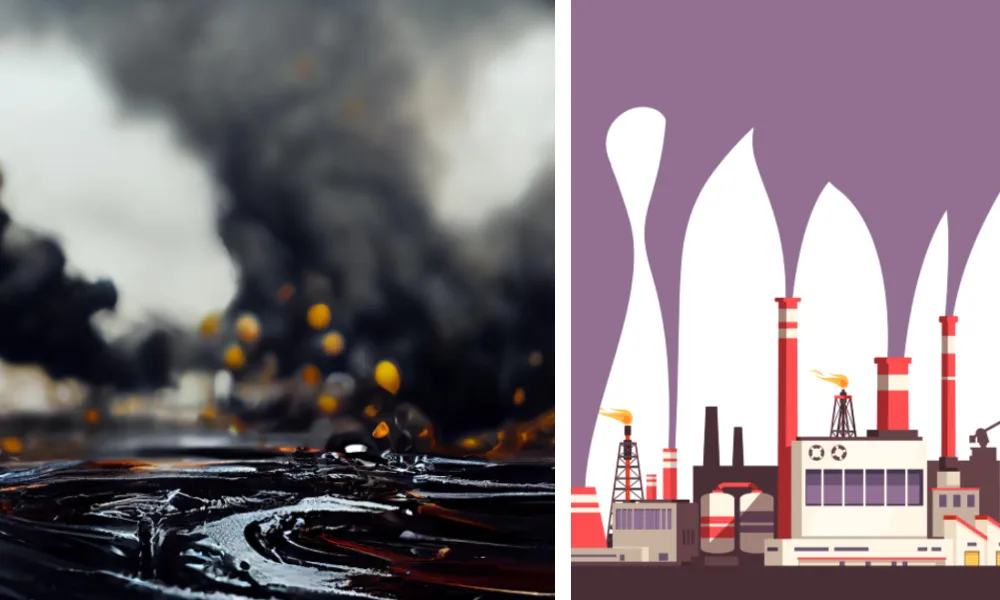IoT Solutions in Refining and Processing (Midstream)
IoT solutions in the oil and gas industry allow companies to manage production processes remotely, significantly reducing the need for human labor. With an increase in data from IoT devices and sensors, the algorithm becomes smarter, which in turn boosts production efficiency and minimizes human errors.
Process Optimization and Control
Let’s explore the role of IoT solutions in the oil and gas industry for process optimization and control:
• Real-time Monitoring of Process Variables: During the refining and processing, application of IoT allows the operators to monitor the live changes of the key process factors such as temperature, pressure and flow rates. This continuous data stream allows them to detect anomalies and make immediate adjustments, thus increasing process effectiveness and overall productivity.
•Advanced Analytics for Decision-Making: The IoT application platform enables data-driven decision-making in refining and processing operations by using the advanced analytics capabilities. Through analysis of data collected from sensors and connected devices operators are able to identify trends, uncover hidden patterns, and make informed decisions that optimize processes, reduce waste, and enhance overall performance, potentially reaching 30-50 times the initial investment within mere months.
Considering the big data and IoT sensors, one can command automation to enhance efficiency. This system does make monitoring so much easier and convenient as employees are required to intervene only when an unusual external error occurs. Otherwise, the whole process is automatic for the best result and the least damage.
Equipment Monitoring and Predictive Maintenance.
In majority of cases, oil and gas industry tend to mine in remote areas. In the same way, it is important to have a system that will notify you if any of the mining machinery needs to be fixed or if something is broken. IoT makes it possible to monitor the condition of most types of equipment in real-time, without human intervention.
IoT devices connected to oil and gas equipment can provide the following benefits:
• Reducing Downtime and Maintenance Costs: IoT technology used in the refining and processing allows continuous measurements of the equipment performance, discovering the possible problems even before they are developed. It also allows companies to avoid costly downtime and save on maintenance costs.
• Extending Equipment Lifespan: Utilizing IoT for predictive maintenance, operators can understand deterioration of the equipment, thus, they can schedule the maintenance at the correct time and operate the equipment efficiently. By being proactive this strategy reduces equipment breakdowns, prolongs the equipment life, and ultimately maximizes the return on investment.
• Generating Digital Twins (virtual models of physical assets reflecting their processes, states, and lifecycle): When failure occurs, digital twin technology is used to diagnose the problem, identify its cause, and find a solution. This approach improves the asset management and efficiency making a comparative performance analysis among assets possible.
Safety and Environmental Monitoring
IoT solutions in the oil and gas industry also enhance safety and environmental monitoring:
• Gas Leak Detection: Faster identification of any leaks by advanced sensors and monitoring systems makes it possible for operators to address the problem right away and avoid accidents.
• Emission Monitoring and Control: Through the analysis of real-time data on emission, firms can take informed decisions to alter their processes, thus, reducing their environmental footprints and remaining within the confines of environmental laws.
IoT Applications in Oil and Gas Logistics and Distribution (Downstream)
Incorporating IoT solutions in the oil and gas industry has resulted in substantial progress in the logistics and distribution operations. Transparent tracking and proactive materials and equipment management implementation leads to a material cost reduction of 10% to the business. At scale, the new industry value could be $30 billion, or a 2 to 3% decline in the cost per barrel of oil equivalent (BOE).
Fleet and Asset Tracking
IoT solutions in the oil and gas industry for fleet and asset tracking use connected devices to monitor and manage vehicles and assets in real time.
• Real-Time Shipment Tracking: Enhanced connectivity can transform the whole process of logistics and supply chain in the oil & gas industry through IoT. This encompasses improved demand management, visible material tracking, and leaner logistics processes. The technology makes scheduling very precise, thus, minimizing the probability of losses and detecting the delays or blockages in the supply chain.
• Optimizing Asset Utilization: The systems enabled by IoT are able to measure a continuity of use and performance of an asset and can help identify inefficiencies and underutilized resources. Such data-driven approach allows organizations to make rational choices on asset allocation and maintenance schedules resulting in maximum ROI and reduced operational costs.
Storage Facilities Remote Monitoring.
IoT solutions in the oil and gas industry enhance remote monitoring of storage facilities by providing live information on vital parameters and enabling proactive risk control.
- Inventory Management: The technology of IoT has improved the system of inventory control at the storage facilities of oil and gas. With the help of IoT enabled sensors and devices, the levels of materials stored are monitored on a constant basis and the inventory records are updated automatically. This in turn reduces the risk of stock outs or carrying too much, thereby improving inventory planning.
- Safety and Security Measures: IoT devices can improve the safety and security of storage facilities by controlling critical parameters like temperature, pressure, and hazardous gases. Moreover, the surveillance systems which are IoT-enabled can also detect unauthorized access or threats which help in keeping valuable assets and staff safe.
- Smart Metering and Billing: IoT in smart metering and billing is about employing smart devices to measure utility consumption and automate precise billing processes.
- Accurate and Efficient Billing Systems: IoT-enabled smart meters improve billing in the oil and gas industry through provision of precise, real-time data on energy usage. This data helps companies produce correct and timely invoices which in turn reduces the number of errors and disputes and increases the cash flow.
- Enhanced Customer Service and Experience: Smart metering systems enable customers to know how they utilize energy and in so doing, they can make smart decisions on consumption and cost management. Through the provision of individual energy saving recommendations as well as tailored pricing plans, oil and gas companies can enhance customer satisfaction and loyalty.
Other Oil & Gas Industry Technologies
1. Artificial Intelligence
The oil & gas industry is rapidly adopting AI and data science to resolve difficult issues in upstream, midstream, and downstream operations. AI-enabling platforms provide decision support in the form of predictive, prescriptive, and cognitive analytics. This way, AI helps petroleum engineers and oil & gas industry managers to find and deploy new exploration & production ideas in the field to maximize ROI.
2. Big Data & Analytics
Unstructured data in the oil & gas industry is created by operational activities on a daily basis. Big data platforms assist the industry’s data analysts in deriving insights from production and performance data. This is also valuable for engineers, seeking to maximize production and ensure reservoir safety. In addition, historical data of previous operations help to train and test AI-driven algorithms and models. Big data analytics allow the oil & gas industry to get more out of the daily decisions that result in the industry’s operational cost and carbon emissions reductions.
3. Robotics & Automation
Frequently, oil & gas operators work in intricate and hazardous environments, which is a threat to human life. To mitigate this risk, the oil industry is adopting robotics & automation solutions to improve workplace safety as well as speed of operations. Robots are also utilized for survey, inspection and industrial automation in oil rigs and refineries. Robotics and automation are therefore, the tools that help in the increase of the speed of operations, reduction in the manpower requirement, increase in efficiency, reduction in human-induced errors.
Robot-as-a-Service (RaaS) Solutions Robots at the startup include First Responder that deals with explosive gas incidents, Emissions Detector that handles fugitive emissions, Co-Operator that operates in remote facilities, and Investigator that does data collection.
4. 3D CAD and Rendering Applications
3D modeling and high-quality visualizations enables generation of photorealistic models of subsurface reservoirs and other O&G facilities.
3D modeling together with historical production data models the production and injection phases of the reservoir life cycle. This also enables to forecast threats that affect the safety of the reservoir.
Using the data, the oil & gas engineers tune the production and operations planning. the 3D modeling and visualization cuts down costs and minimize risks and ensures higher performance for oil & gas assets.
5. Cloud Computing:
Cloud computing can store and process data on distant servers, thus, saving costly local storage and processing capacities.
The oil & gas industry produces vast quantities of data on a daily basis.
Cloud technology and software applications improve oil & gas efficiency, security, scalability, and also facilitates digital transformation.
Cloud native tools in the form of ‘as-a-service’ platforms – platform, storage, infrastructure, data, and more – facilitate sophisticated analytics, informative visual dashboards, and real-time remote access insights.
6. AR & VR :
(AR/VR), mixed reality (MR) and extended reality (XR).
In the oil & gas industry, Reality technology solutions improve efficiency and reduce mistakes by providing real-time information about equipment, tools, and parts.
In particular, reality solutions are used by exploration and production (E&P) companies for remote monitoring, downhole imaging and virtual training.
O&G startups integrate real and virtual spaces so as to facilitate human-machine interactions through the use of wearables and smartphone alerts.
7. MES (Manufacturing Execution Systems)
MES unifies production units, operational technologies like supervisory control and data acquisition (SCADA), and computer systems to regulate production. The processes of oil & gas equipment manufacturing are rather complex, therefore, engineers are in search of the solutions aiming at continuous processes monitoring and control.
MES provides advanced architecture for integrated control of manufacturing systems in the oil & gas section. Thus, it allows the oilfield technologies that guarantee faster, safer, and reliable production.
8. Predictive Maintenance
Predictive maintenance and operations entail collecting data from sensors in field installations and linking it with machine learning algorithms. This allows engineers to know the equipment status fast and take corrective maintenance actions in time. Predictive operations, in conjunction with software platforms, support detailed level part visualizations of the asset so that O&G operators can anticipate possible failures. In addition, predictive maintenance is used all through upstream, midstream and downstream operations. The solutions enhance safety, prolong the life of installations, and minimize the operations and maintenance costs.
9. Blockchain
Block chain is gradually integrating into different oil & gas industrial operations. Smart contracts give required safety and reliability to the oil and gas documents and processes. Distributed ledger verifies the contractor, subcontractor, employee, and maintains the smart contracts. Also, Blockchain enables oil & gas companies to automate invoices, post-trade settlements, and joint venture accounting. Also, blockchain comes in handy in hydrocarbon fleet tracking, trading, retail B2C, intragroup billing.
10. Wearable Technology
Wearable technology, such as helmets, glasses, watches, “smart fabrics” or other wearable devices that workers can wear, is a growing trend in the oil and gas sector for making workers safer and giving them immediate access to information and support in the field, and making critical job functions more efficient.
Challenges of IoT for Oil and Gas Industry
Without a doubt, IoT software plays a very important part in processes, like ordering and robotics, scheduling and so on, of different types of business operation that become more effective.
Despite the benefits, there are challenges in implementing IoT solutions in the oil and gas industry:
Dilemas of Data Security and Privacy
IoT systems as they gather, transport, and save large volumes of critical data are very dangerous for data security and privacy. To protect valuable information and remain compliant with industry regulations, cybersecurity measures need to be robust and potential vulnerabilities in IoT networks should be addressed.
Integration with Existing Systems
Like it has been said before, most of the oil and gas firms still work with legacy systems and equipment. The integration of IoT into oil and gas solutions within these existing infrastructures could be complicated and could take a lot of time, where knowledge of the current systems and a carefully thought out implementation plan are required.
High Initial Investment Costs
Implementation of IoT solutions in the oil and gas industry requires substantial investments in hardware, software and infrastructure modernization. The return on investment (ROI) and long-term benefits of such solutions must be properly evaluated prior to commitment to their implementation.
Talent and Skill Gaps
Attracting high-grade IoT specialists with a full spectrum of knowledge areas – IoT, security, hardware and user needs – can be challenging. With the fast pace of the IoT market, the demand for skilled professionals has grown. Thus, it will probably lead the project cost to escalate and no professional will be available having required skills to finish the project properly.
How to Enhance the Performance of your Oil and Gas Business with IoT Solutions
The implementation of IoT solutions in the oil and gas industry can optimize their operations, minimizing inefficiency and costs. Nevertheless, one issue was already discussed – recruiting IoT developers. Fortunately, eesy-innovation is here for you.
Specialty of eesy-innovation is in integration existing sensors to its communication interfaces like i.e. own 868 MHz protocol, existing standard protocols, Wi-Fi, Bluetooth low energy etc.. Then we send the measurement results through the cloud to a data centre, dashboard, or a smartphone. Then we visualize these data, we analize them and if needed we underly them with AI algorithms to be able make forecasts or recommendations.
Just picture the impact: decision-makers, using real-time data analytics, have the ability to detect improvement areas and act on growth opportunities faster than anyone else with more accuracy. The effect of the ripple is far-reaching – satisfied customers, profitable operations, minimal downtime, and a lean supply chain which leads to a more efficient and profitable business.





